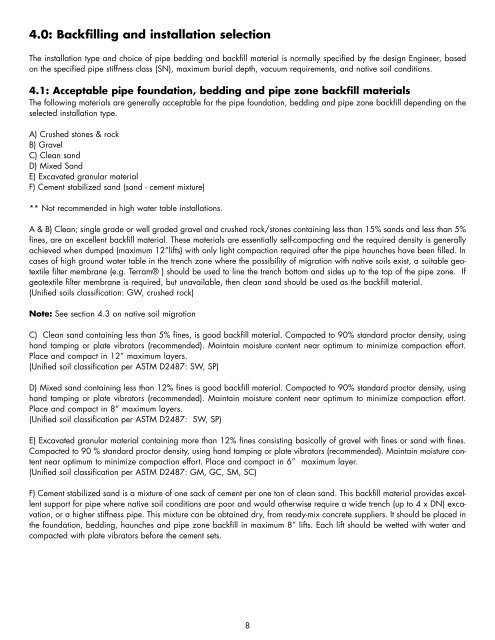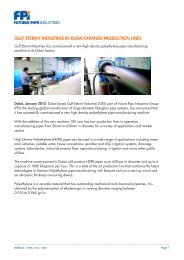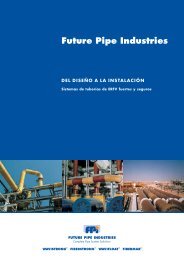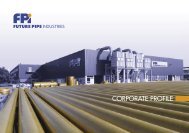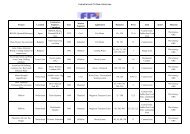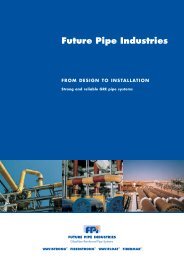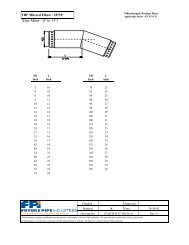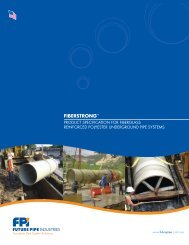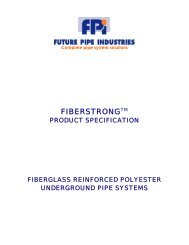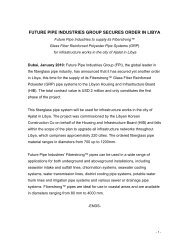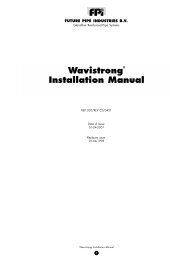Untitled - Future Pipe Industries
Untitled - Future Pipe Industries
Untitled - Future Pipe Industries
You also want an ePaper? Increase the reach of your titles
YUMPU automatically turns print PDFs into web optimized ePapers that Google loves.
4.0: Backfilling and installation selection<br />
The installation type and choice of pipe bedding and backfill material is normally specified by the design Engineer, based<br />
on the specified pipe stiffness class (SN), maximum burial depth, vacuum requirements, and native soil conditions.<br />
4.1: Acceptable pipe foundation, bedding and pipe zone backfill materials<br />
The following materials are generally acceptable for the pipe foundation, bedding and pipe zone backfill depending on the<br />
selected installation type.<br />
A) Crushed stones & rock<br />
B) Gravel<br />
C) Clean sand<br />
D) Mixed Sand<br />
E) Excavated granular material<br />
F) Cement stabilized sand (sand - cement mixture)<br />
** Not recommended in high water table installations.<br />
A & B) Clean; single grade or well graded gravel and crushed rock/stones containing less than 15% sands and less than 5%<br />
fines, are an excellent backfill material. These materials are essentially self-compacting and the required density is generally<br />
achieved when dumped (maximum 12”lifts) with only light compaction required after the pipe haunches have been filled. In<br />
cases of high ground water table in the trench zone where the possibility of migration with native soils exist, a suitable geotextile<br />
filter membrane (e.g. Terram® ) should be used to line the trench bottom and sides up to the top of the pipe zone. If<br />
geotextile filter membrane is required, but unavailable, then clean sand should be used as the backfill material.<br />
(Unified soils classification: GW, crushed rock)<br />
Note: See section 4.3 on native soil migration<br />
C) Clean sand containing less than 5% fines, is good backfill material. Compacted to 90% standard proctor density, using<br />
hand tamping or plate vibrators (recommended). Maintain moisture content near optimum to minimize compaction effort.<br />
Place and compact in 12” maximum layers.<br />
(Unified soil classification per ASTM D2487: SW, SP)<br />
D) Mixed sand containing less than 12% fines is good backfill material. Compacted to 90% standard proctor density, using<br />
hand tamping or plate vibrators (recommended). Maintain moisture content near optimum to minimize compaction effort.<br />
Place and compact in 8” maximum layers.<br />
(Unified soil classification per ASTM D2487: SW, SP)<br />
E) Excavated granular material containing more than 12% fines consisting basically of gravel with fines or sand with fines.<br />
Compacted to 90 % standard proctor density, using hand tamping or plate vibrators (recommended). Maintain moisture content<br />
near optimum to minimize compaction effort. Place and compact in 6” maximum layer.<br />
(Unified soil classification per ASTM D2487: GM, GC, SM, SC)<br />
F) Cement stabilized sand is a mixture of one sack of cement per one ton of clean sand. This backfill material provides excellent<br />
support for pipe where native soil conditions are poor and would otherwise require a wide trench (up to 4 x DN) excavation,<br />
or a higher stiffness pipe. This mixture can be obtained dry, from ready-mix concrete suppliers. It should be placed in<br />
the foundation, bedding, haunches and pipe zone backfill in maximum 8” lifts. Each lift should be wetted with water and<br />
compacted with plate vibrators before the cement sets.<br />
8


